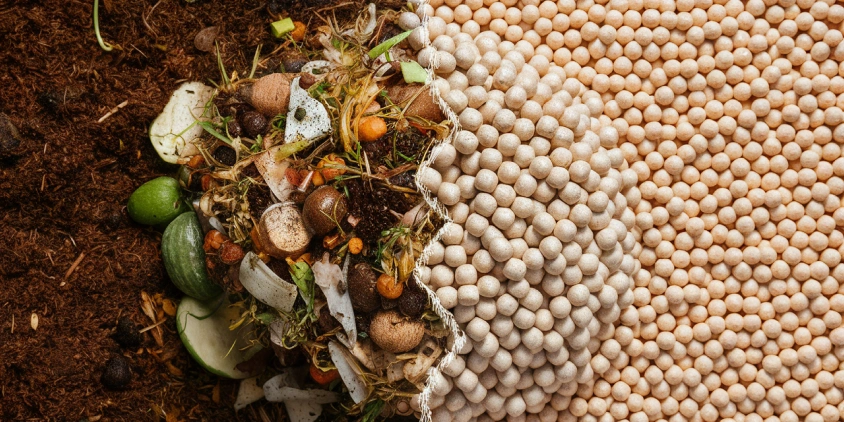
Organic Vs. Synthetic Fertilizers: Differences And Uses
There is a schism in the agricultural community over the use of organic fertilizers vs. synthetic ones. This age-old debate has roots that run deep, with proponents on both sides defending their chosen methods. Organic fertilizing products, derived from natural sources like decomposed plant matter or animal waste, offer a gentle and sustainable approach to soil enrichment. In contrast, synthetic fertilizers provide a potent blend of chemical compounds, promising immediate results but raising questions about their long-term effects. This article explores the intricacies of this ongoing organic vs. synthetic fertilizer discussion, offering insights and tools to help you navigate the world of crop nourishment.
What Is The Difference Between Organic And Synthetic Fertilizers?
The three main nutrients — nitrogen, phosphorus, and potassium — in a certain proportion are present in both types of fertilizers. However, this is merely the only similarity between organic and synthetic fertilizers. The first difference, in lay terms, is that organics nourish the soil, while synthetics nourish the crops. This assumption is partially accurate, and the illustration below depicts the true essence of organic vs. synthetic fertilizing in terms of delivering nutrients to the plant.
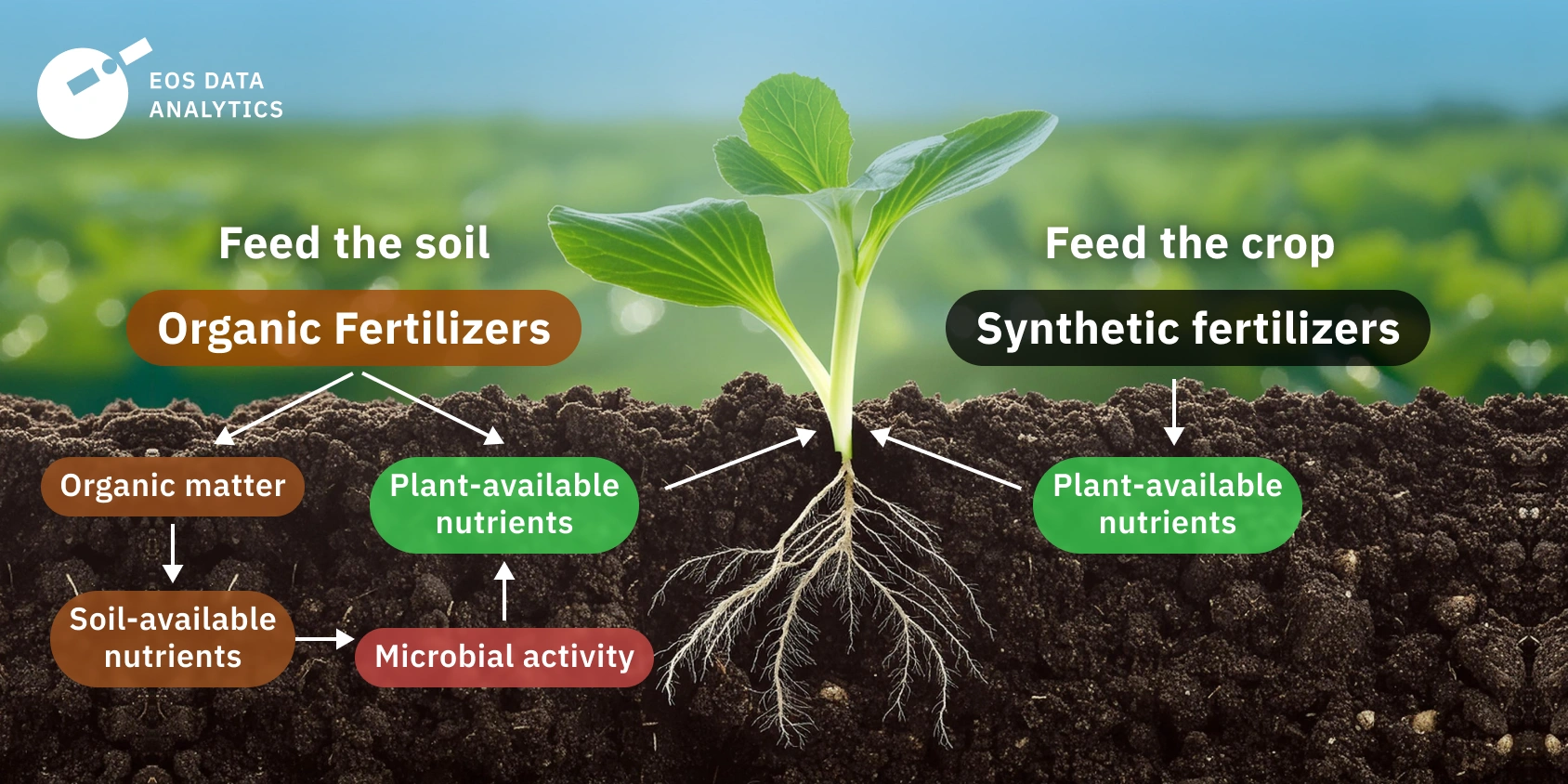
The other differences between these two types stem from their nature. You can learn more about them in the following table.
| Feature | Organic fertilizers | Synthetic fertilizers |
|---|---|---|
| Nutrient concentration | Lower concentrations, thus greater amounts must be used | Higher concentrations, thus smaller amounts can be used |
| Consistency | The amount of nutrients varies | Defined amount of nutrients |
| Convenience for large farmers | Small packets and “raw” forms of organic products typical on the market are not practical for large-scale farmers | Numerous package sizes and forms of chemical products to suit the needs of large farmers |
| Nutrient release rate | The rate of nutrient release is optimal for plant uptake | Nutrients are rapidly released in quantities that may be excessive for plant uptake |
| Safety for plants | Relatively risk-free; root burns are extremely seldom | Because of the high salt content, there’s a high risk of burning plant roots or leaves |
| Effects on soil | Help keep the soil healthy by adding organic matter | Deleterious effects on soil microbiology and chemical structure over time |
| Safety for the environment | Minimal risk of environmental pollution | High risk of leaching and greenhouse gas emissions |
Use variable rate application (VRA) technology to maximize the effectiveness of either organic or synthetic fertilizers (for synthetics, though, it’s more practical). The variable rate maps pinpoint exactly where fertilizing is required by detecting areas with less and more vegetation. To determine how much nitrogen to apply during cultivation, use VRA maps based on current crop growth monitoring and vegetation density data, whereas for phosphorus and potassium application at planting, generate maps based on the long-term data, spanning up to 7 years. Our maps are available for download and are compatible with a wide range of agricultural machinery.
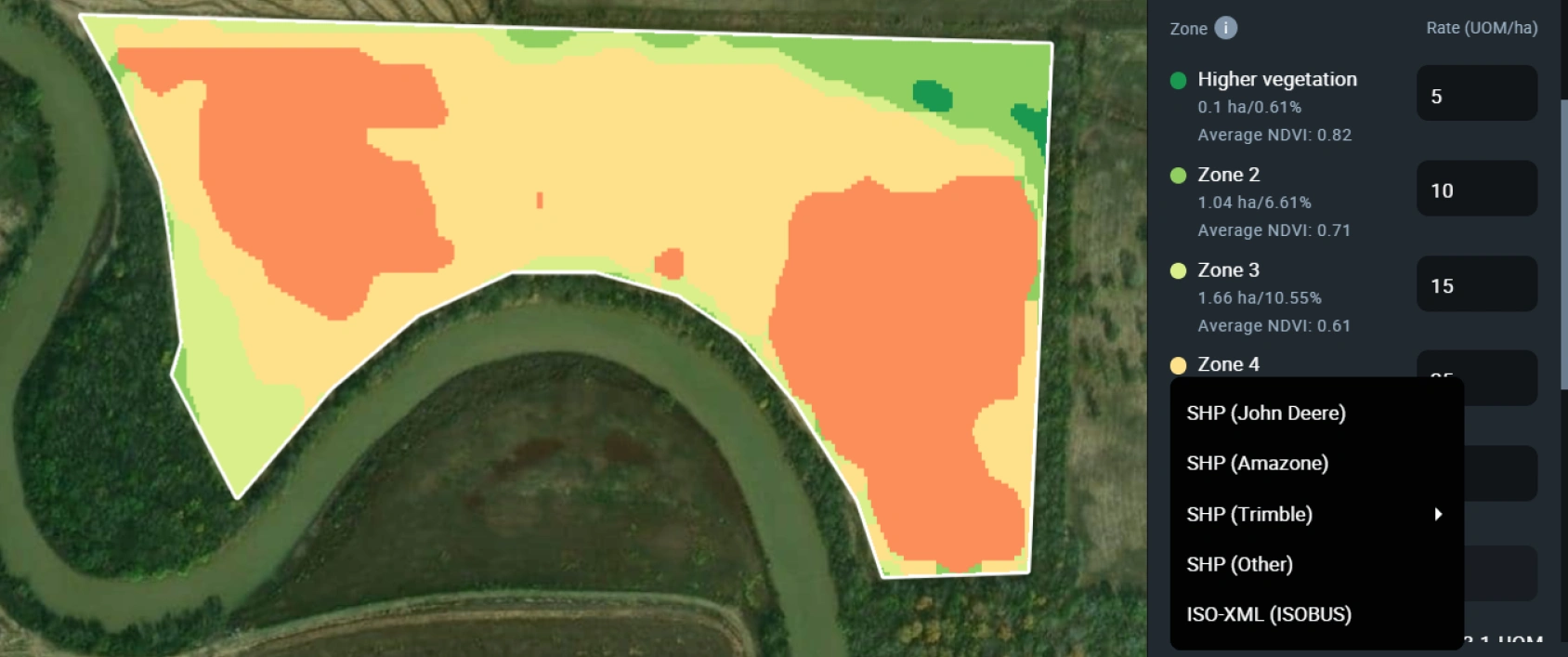
What Is Organic Fertilizer?
Organic fertilizers are made up of plant, animal, or (rarely) mineral-based compounds that frequently undergo natural biochemical reactions like fermentation. To make organics usable for plants, soil bacteria first break them down into soluble nutrients. When applied properly, organic fertilizers, unlike synthetic ones, help both crops and soil.
Unlike conventional fertilizing products, which often lack the meso- and microelements needed for plants, organic feeding provides these. However, organically derived products contain less nitrogen, phosphorus, and potassium (NPK), so their effects on crops are more subtle.
What Is Synthetic Fertilizer?
Synthetic fertilizers are made from ammonia, atmospheric nitrogen, phosphate minerals, and other chemicals through human-controlled chemical reactions, such as the Haber process. Their quick-acting nature and variety of forms (liquid, powder, granule, and spike) make them renowned for providing a surge of macronutrients and noticeable results quickly. Nevertheless, the effect on plants does not last long (unless you apply slow-release forms), so you should reapply chemicals throughout the most nutrient-intensive stages of plant growth.
Synthetics have a short payoff time, but they come with risks, such as leaching, increased soil nitrate levels, or burning the plants if applied in excess . Yet, farmers can avoid these harmful consequences by applying synthetic fertilizer in the appropriate amounts through VRA.
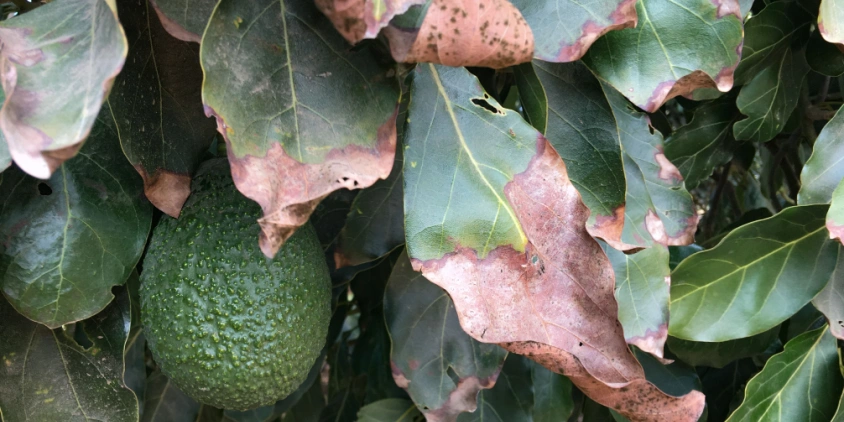
Synthetic Vs. Organic Fertilizers: Pros And Cons
Either synthetic or organic fertilizer can be beneficial for farmers under specific circumstances. When devising a fertilization strategy, you must consider the strengths and weaknesses of each type.
Organic Fertilizers’ Advantages And Disadvantages
Because they contain a lot of organic matter and have lower salt concentrations, organic fertilizers, unlike synthetic ones, are beneficial for soil ecosystems. In more detail, the advantages of organic feeding are the following:
- Improved soil fertility and health. Incorporating organic matter-rich feeding into the soil improves its structure and fertility by encouraging the activity of earthworms and microbes.
- Better water retention. Thanks to the improved soil structure, both the soil’s water-holding capacity and water infiltration are improving.
- Complete nutrient uptake by plants. Organic fertilizers, in contrast to synthetic products, gradually release nutrients, allowing plants to receive all the nutrients they need for growth without stress or overfertilization.
- No accumulation of toxins in the soil. There are no toxic compounds or salts released by these products that would build up in the soil.
Organic fertilizers’ chemical makeup, created by natural reactions instead of being manufactured in chemical laboratories, isn’t fixed, readily measured, or immediately available to plants. Hence, the disadvantages of organic plant feeding are:
- Difficult to apply precisely. The amount of nutrients in natural fertilizing products is inconsistent and depends on lots of uncontrollable factors. As a result, if you apply the same amount of a certain feeding, such as compost, you’ll probably deliver different amounts of nutrients each time.
- Slower outcomes. Organic fertilizers vs. synthetic won’t work until they decompose into plant-available form, which might take a few months.
- Dependence on soil microbes. If there aren’t enough microorganisms or their activity isn’t sufficient, natural feeding will not yield the desired results (organics do, however, aid in the restoration of beneficial bacteria over time) .
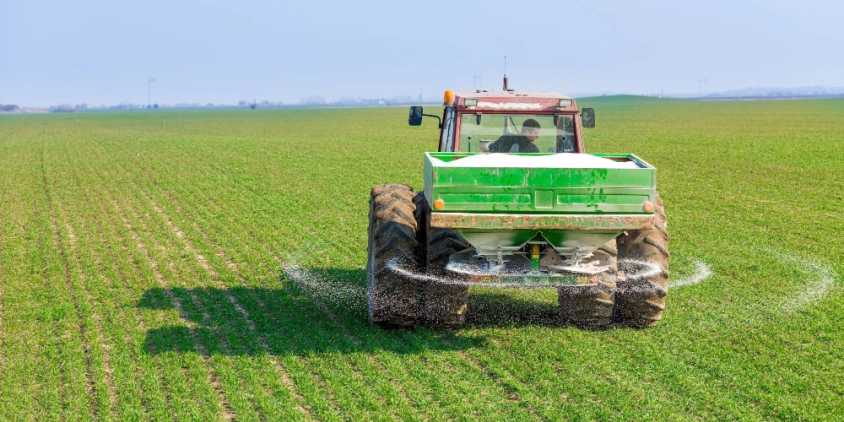
EOSDA Crop Monitoring
Fields monitoring platform, leveraging high-resolution satellite images to identify and react to any changes remotely!
Synthetic Fertilizers’ Advantages And Disadvantages
Being mass-produced, synthetic fertilizing products have their formulas precisely calibrated, come in a variety of forms to cater to the diverse needs of farmers, and are priced to be affordable for all. More specifically, the pros of synthetic fertilizers are the following:
- Better command. You can carefully manage the amount of each nutrient and its concentration when you apply synthetic fertilizers, unlike organic ones. With the advent of slow-release or fast-release chemicals, you can also regulate the rate at which the product takes action.
- Faster outcomes. In contrast to natural materials, which take longer to decompose, fast-release chemicals are absorbed by plants much more rapidly and have relatively immediate effects — within days rather than weeks.
- Convenient application options. Chemicals, liquid or water-soluble, can be sprayed as foliar feeding or delivered immediately to crop roots through fertigation systems.
- More affordable. When compared to natural, mass-produced synthetic fertilizers with a long shelf life are more cost-effective.
- Blend well with other products. You can easily mix synthetic fertilizing products with other chemical solutions, like insecticides or herbicides. As a result, you may feed your crops more efficiently and spend less time on agricultural activities.
On the other hand, synthetic fertilizers are not without disadvantages. In particular, they are criticized for:
- Lack of meso- and micronutrients. While they contain the three essential nutrients, they typically lack the trace nutrients that a crop would obtain from organically decomposing materials.
- Environmental pollution. Most synthetic fertilizers, in contrast to natural ones, tend to run off and volatilize, contaminating the soil, water, and air and potentially reaching far-flung places.
- Altering soil pH. Long-term chemical applications may affect your soil’s pH balance, making it hostile to beneficial insects and microorganisms.
- Overfertilization. Because synthetic fertilizing products are extremely concentrated, they are easily overused, for example, resulting in fertilizer burn.
- More frequent applications. Synthetic fertilizers, unlike organic ones, have a short-term effect and must be applied multiple times throughout the growing season.
What Fertilizer To Choose: Organic Or Synthetic?
Both types have their advantages and disadvantages, yet there is no clear winner. For rapid results on crops, use synthetic fertilizers vs. organic fertilizers for gradual soil health restoration. Whatever product you choose, apply it when, where, and how much is needed.
Yes, combining synthetic and organic fertilizers is a winning strategy. Say, you can apply compost/manure before planting and mineral N-fertilizer during critical growth stages (tillering and stem elongation in grain crops, branching in vegetables).
Schedule organic or synthetic fertilizing based on the plant’s growth stage using EOSDA Crop Monitoring’s in-built BBCH growth stage calculation for the 40 most common crops (and more to come). Make sure to keep track of the plant development timeline across all of your fields so you can strategically apply synthetic feeding when needed.

Furthermore, our precision farming capabilities lend agricultural consultants a hand by informing their fertilization advisory services throughout the growing season. Growth stage data, VRA maps, historical weather and forecasts, multi-field crop monitoring, field operation planning, and crop rotation history are just a few of the EOSDA Crop Monitoring features that help agricultural consultants enhance their expertise, give more accurate advice, and promote a smarter way of applying organic and synthetic fertilizers.
About the author:
Vasyl Cherlinka is a Doctor of Biosciences specializing in pedology (soil science), with 30 years of experience in the field. He attended the engineering college in Ukraine and received his degree in agrochemistry, agronomy and soil science in the Chernivtsi National University. Since 2018, Dr. Cherlinka has been advising EOSDA on problems in soil science, agronomy, and agrochemistry.
Recent articles
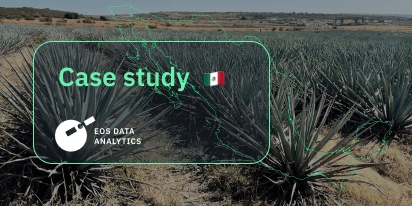
Digital Tools Improve Soil Health And Yields In Mexico
EOSDA and ITTA supported a Guanajuato farm with contour-line planning, monitoring tools, and practical guidance to reduce soil erosion and improve yields in the long run.

Analyze 2025 & Plan Your Best Year Yet: LandViewer Christmas Offer
It’s the most wonderful time of the year! The Christmas holidays are here, and so is your chance to analyze 2025 and plan a prosperous 2026 with more affordable Pro plans in LandViewer.

EOSDA Models Climate Change Impact On Sugarcane Yields
EOSDA modeled future temperature, rainfall, and other climate impacts on Veracruz sugarcane. The results help growers plan long-term adaptation strategies, including timing, varieties, and irrigation.